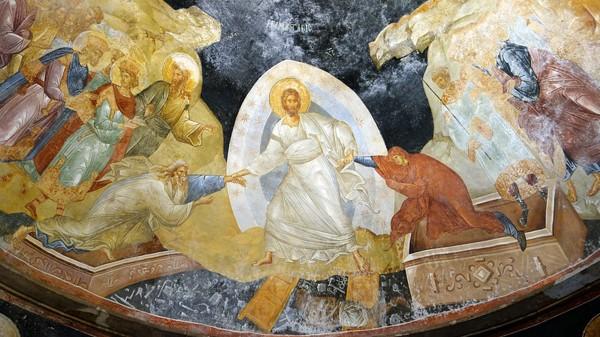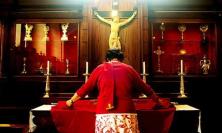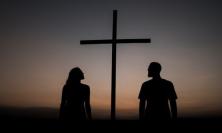(Image shared via Creative Commons CC BY-NC-SA 2.0)
The Church’s Office of Readings for Holy Saturday includes a text in which Christ, who has descended into Hell, is in conversation with Adam – but what might Christ and Eve have said to one another? Karen Eliasen takes her cues from the Spiritual Exercises and depictions of ‘The Harrowing of Hell’ to shape a space in which we might imagine that dialogue, and considers how doing so might help us to look again at the story of Eve and its implications for women right up to the present day.
Adam’s absence from the title of this article may not have escaped anyone’s notice – although the chances are that had that title instead been, ‘When Adam met Jesus,’ Eve’s absence would probably have escaped the notice of most. Title-noticing is all in the eyes of the beholder, and my own eyes these days are drawn irresistibly to behold Eve in all her guises – and as we approach Easter that guise becomes for me her direct link to Jesus Christ. Nowhere within the Christian tradition is that link between Jesus and Eve made more explicit than in the ancient icons and stories tackling the enigmatic Holy Saturday adventure known as ‘The Harrowing of Hell’. And nowhere within the Christian tradition do we find a better suggestion of a ‘way of proceeding’ when it comes to imaginatively meditating upon Eve and Jesus and Hell in the same breath than in the Ignatian Spiritual Exercises. So as a daughter of Eve armed with an inspiring icon or two, a suggestive Ignatian text, an eye on recent headlines and a dash of feminist theology, I want to offer some brief considerations of what might be conceivable between Eve and Jesus on Holy Saturday, and why we might want to be particularly attentive to that this year.
In the most compelling of the many icons of ‘The Harrowing of Hell’, a very serious-looking, strong-looking and male-looking Jesus stands astride the entrance to Hell. He stands firmly with legs planted wide apart, but at the same time he seems on the move as his robes billow grandly about him and each hand grasps someone by the wrist – one hand a woman, and the other a man, who are of course Eve and Adam. Jesus’s strong stance and his serious demeanour, even his insinuated maleness, tend to vary little from icon to icon over the centuries. What does vary is the entrance to Hell – from the viciously toothed jaw of a gigantic monster to a darkened cave in a mountainside to a simple black hole between coffins. What also varies is how Eve and Adam interact with the harrowing Jesus. They might be standing, kneeling, pleading, with arms crossed or reaching out untouched, or, as already mentioned, grasped by the wrist. Among the grasped-wrist icons, sometimes it is only Adam’s wrist that is grasped, with Eve standing either behind or beside Adam – who then sometimes grasps her wrist in a kind of chain reaction. But on occasion Eve’s wrist is grasped by Jesus himself, and this is the variation among the ‘Harrowing of Hell’ icons that I find the most compelling.[i] In their book, Resurrecting Easter: How the West Lost and the East Kept the Original Easter Vision,[ii] John Dominic and Sarah Sexton Crossan observe the shifting hands of Jesus, Adam and Eve in these icons across time, and in noting the inclusion of Eve’s wrist forthrightly ask: ‘Is a move toward a later Byzantine feminism too modern to consider?’ Probably yes – but then again, perhaps feminism is fundamentally as ancient as Eve.
Of the icons that include this direct physical touch between Eve and Jesus, some have Jesus looking at Adam, some have him looking out at the viewer, and some vaguely elsewhere; but I have not come across any in which Jesus is looking directly at Eve, let alone in which they are obviously looking at each other. And yet there exists a long tradition of depicting Eve and God as looking intensely at each other – an image search for ‘God creates Eve,’ or something to that effect, will leave you overwhelmed by centuries of Christian art showing God and Eve caught up in a mutual gaze of love and longing. In all these many depictions, Eve even in her limpness comes across as responding with a ‘yes’ of some sort to this God beckoning her away from a thoroughly unconscious Adam. Always they are reaching out towards one another, and in many God is touching Eve, be it on her shoulders or arms or hands; in a few God even grasps Eve’s wrist as he pulls her out of Adam, much as Jesus does when he pulls her out of Hell.[iii] A loving God who creates and a loving son of God who saves – these are the basic truths of the Christian story, truths we must not lose sight of as we engage not just more deeply, but more radically, with Eve’s story.
I use the word ‘radically’ here because I want to highlight a part of Eve’s story that is too often forgotten or even intentionally left out, but one that turns up on Holy Saturday and links Eve directly to Jesus. When it comes to the sonship of Jesus, we may think we know all the variations on his ancestry: son of God, son of Man, son of Adam, son of David, and son of Mary. But here is the one that is rarely acknowledged about Jesus’s roots: son of Eve. Sometime in the second or third century, an anonymous homilist did acknowledge just that about Jesus, and included it in an action-packed retelling of ‘The Lord’s descent into the underworld’. It is a very weird and exquisitely wonderful text that the Church’s Office of Readings includes as the Second Reading on Holy Saturday,[iv] and in it we find this reference to Eve: ‘he has gone to free from sorrow the captives Adam and Eve, he who is both God and the son of Eve.’ The homily goes on to record an impassioned dialogue between Adam and this son of Eve, who then ‘took [Adam] by the hand and raised him up’. Although Eve has been mentioned, she does not figure in any of these exchanges of word or action; but anyone familiar with Ignatian prayer techniques knows that such an omission is no deterrent to considering that something or other gets exchanged between Eve and Jesus. What might that something or other be?
The prayer that kicks off the Fourth Week of the Ignatian Spiritual Exercises offers an imaginative platform for taking that question deeper. In that prayer, Ignatius asks us to imagine that the very first person the risen Christ meets is Mary, his mother – but not before he has made that jaunt into the underworld and completed the Harrowing of Hell:
After Christ died on the Cross his body remained separated from the soul but always united with the divinity. His blessed soul also united with his divinity, descended into Hell. From there he released the souls of the just; then, returning to the tomb and rising again, he appeared in body and soul to his blessed Mother.[v]
Theologies about souls and divinities aside, something Ignatian can still be done with a narrative in which Christ ‘descended into Hell. From there he released …’ if we imagine that the very first person the descended Jesus meets and releases is Eve.[vi] And just as we let our current times and predicaments influence how we imagine Jesus’s encounter with his mother, so we can do the same as we imagine his encounter with Eve. But there is a snag here, in that as an influencer at large Eve has had, and continues to have especially in secular culture, a far wider range than Mary.[vii] So at this point I am going to add that dash of feminist theology I promised at the beginning, by resorting to an outsider, Rebecca Solnit.
The powerful sway that the Eve-story still holds over us is all too familiar, but perhaps nonetheless still shocking in this day and age. Simply to take in the news is to be confronted with the truth of this. The Guardian recently ran an article in which Rebecca Solnit addresses the current spate of news items about violence against women. The article has the subheading: ‘When men harm women, we obscure their role. Instead, we blame women for the injustice that happens to them’, and not surprisingly Solnit brings in the Old Testament Eve-story, and Christianity’s take on that story, as an ancient contributor to women’s current ills.[viii] But to give Solnit her due as a critic, she has in the past written far more constructively about Eve. In her collection of essays published twenty years ago and entitled, As Eve Said to the Serpent: On Landscape, Gender, and Art,[ix] Solnit muses about Eve:
Imagine Eve as one of the few scientists to discuss the long-term consequences of her acts before she began her apple-eating experiment. Imagine what she and the snake might have had to say to each other about becoming symbols and scapegoats, about how they would be represented and misrepresented.
If such a premise can be imagined for Eve and her conversations at the very beginning of time, then consider that a similar premise can be imagined for her conversations at the very end of time. One obvious question then lurks: ‘So, Eve the apple-eating scientist! You discerned, you decided, you acted – and how have things turned out for you?’ The unexamined Christian answer is of course that Eve has deservedly ended up in Hell, and so end of story – except that now, on Holy Saturday, someone has come to save her. I can imagine that as Eve, in conversation with her saviour, considers the outcome of her experiment, Solnit’s vocabulary of ‘scapegoats’ and ‘misrepresented’ turns up again. I can imagine this because I, a daughter of Eve, have deep-rooted concerns over how Eve has been scapegoated and misrepresented: not questioning so much the fact that Eve sinned, but questioning rather the nature of her sin, and what that nature has to do with her sex.
To set my deep-rooted concerns within a Christian take on how things actually have turned out for Eve and her daughters, who better to quote than Tertullian. Some 1800 years before Solnit’s and my generation, he penned the worst of what any Christian text has to say about women:[x]
Do you not know that you are each an Eve? The sentence of God on this sex of yours lives in this age: the guilt must of necessity live too. You are the Devil’s gateway: You are the unsealer of the forbidden tree: You are the first deserter of the divine law: You are she who persuaded him whom the devil was not valiant enough to attack. You destroyed so easily God’s image, man. On account of your desert even the Son of God had to die.
Hardcore sexists might readily enthuse along with Tertullian in calling all women ‘the Devil’s gateway;’ some might even assume from Tertullian’s words that all women are thoroughly beyond saving simply because women are essentially an unsalvageable sex. That is how bad it looks for women if sexism is extrapolated to its extreme disposition: unsalvageable. But not even Tertullian himself took it that far, as this later quote from the same work makes clear:
You too (women as you are) have the self-same angelic nature promised as your reward, the self-same sex as men, the self-same advancement to the dignity of judging.
Nevertheless, the fact that modern, secular versions of ‘Devil’s gateway’-type of opinions of women remain ubiquitous (all those news stories), suggests to me the legitimacy of asking that radically insurgent question that the feminist theologian Rosemary Radford Ruether asked a generation ago: ‘Can a male saviour save women?’[xi] Can Eve, who trusts God grasping her wrist at her creation, trust that serious and strong male grasping her wrist at the entrance to Hell? I cannot help but entertain the idea that Eve and Jesus have it out on this score of both sex and gender, tied up as both sex and gender are with scapegoats and misrepresentations. I like to believe that in her conversation with the Son of God on Holy Saturday, something new emerges in and for Eve, perhaps even about Eve and all her daughters, something that is unsullied by mansplaining – to which I am convinced the Son of God, for all his maleness, never ever stoops. For Jesus is after all also the Son of Eve.
Karen Eliasen works in spirituality at St Beuno’s Jesuit Spirituality Centre, North Wales.
[i] Have a look at a detail showing the wrist-grasped Eve in a 14th century fresco from Istanbul at https://live.staticflickr.com/714/22483393013_73fa43e5a6_b.jpg
[ii] HarperOne, 2018.
[iii] See the wonderful example from the12th century Souvigny Bible at https://editorial01.shutterstock.com/wm-preview-1500/5850777qd/a988c602/art-manuscript-various-shutterstock-editorial-5850777qd.jpg , or the stained glass from Chartres Cathedral at https://www.researchgate.net/profile/Francis-Marchese/publication/267391617/figure/fig3/AS:392028232929282@1470478222139/Chartres-Cathedral-Bay-44-panel-15-God-creates-Eve-out-of-Adams-rib-Photo-C-Stuart_Q640.jpg. In both be sure to admire the intense mutual gaze between Eve and God.
[iv] Read this Ancient Homily for Holy Saturday at https://universalis.com/20210403/readings.htm or elsewhere - just a warning that in some versions the original has been doctored by replacing ‘son of Eve’ with ‘son of Adam’.
[v] Ignatius of Loyola, Spiritual Exercises §219.
[vi] It seems that this very idea inspired the 12th century metalworker, Nicholas of Verdun, whose altarpiece in the Klosterneuburg Monastery near Vienna includes a plaque depicting the Harrowing of Hell, in which Jesus is grasping Eve’s – and only Eve’s – wrist: https://www.christiancentury.org/sites/default/files/013118anastasis3.jpg
[vii] A few examples that I have greatly enjoyed recently: watching the BBC’s Killing Eve with its apple-munching heroine, and Amazon’s The Wilds, an excellent psychological sci-fi about a group of difficult teenage girls heading for a retreat called ‘The Dawn of Eve’. Reading Angela Carter’s unsettling fantasy, The Passion of Eve, and a collection of early 20th century sci-fi short stories by various women simply called New Eves. There is plenty of Eve-stuff, and not much Mary-stuff, out there – which seems like an invitation to Christians to go back to the drawing board.
[viii] Rebecca Solnit, ‘Women are harmed every day by invisible men’, The Guardian (19 March 2021): https://www.theguardian.com/commentisfree/2021/mar/19/women-harmed-every-day-invisible-men
[ix] University of Georgia Press, 2003.
[x] From Tertullian’s On the Apparel of Women, Book I, Chapter I. Although as a prolific writer Tertullian has been called the Father of Latin Christianity, he was never made a saint.
[xi] Read the relevant extract from Ruether’s 1981 book To Change the World: Christology and Cultural Criticism (Crossroad, 1981) at https://peped.org/philosophicalinvestigations/article-can-male-saviour-save-women/. As long as women are blamed and silenced, these questions must be asked.






